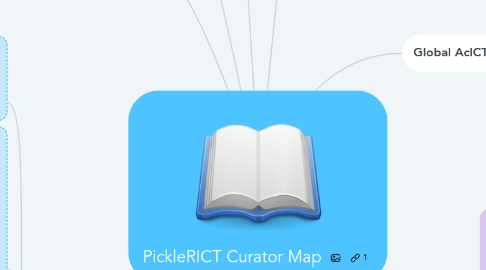PickleRICT Curator Map
von Molly Roth

1. UDCMM
1.1. For our first resource, we used Alex's grandmother. She used to tell Alex her own version of Little Red Riding Hood and we have an audio of it that we reffered to!
1.2. For the Codey Rocky activity, we mainly used the manual of the robot and created a lesson based off of that!
1.3. In order to make the comic, we used a free Microsoft platform called Sketchbook
2. #WeStayAtHome
2.1. We used BlackBoard Collaborate to have online class with Linda.
2.2. We also used various platforms in order to film our videos and cut them together. Ex. Photobooth and Imovie
3. Digital Comic
3.1. Lemke, C. (2010). Innovation through technology. 21st-century skills: Rethinking how students learn, 243-272. Mostly, we paid attention to the three types of innovation that were highlighted: the fuel for a knowledge-based economy, democratization of knowledge, and participatory learning.
3.2. To have a clear view of the type of comic we were going to create, we looked up information regarding the "13 rue del percebe," by Francisco Ibáñez. Robles, J. M. (2018, 23 enero). Así sería hoy la España de '13, Rue del Percebe'. Recuperado 26 marzo, 2020
4. Group PLE
4.1. Castañeda, L., & Adell, J. (2013). THE ANATOMY OF PLE. Recuperado 2 abril, 2020, de https://aulavirtual.um.es/access/content/group/5438_G_2019_N_N/Bilingual%20Group/Chapter1Castaneda_Adell2013EN.pdf
4.2. Podcast Sources: Maximum Fun | Artist owned, audience supported https://open.spotify.com/ https://choice.npr.org/index.html?origin=https://www.npr.org/podcasts/474377890/but-why-a-podcast-for-curious-kids https://www.littlestoriestinypeople.com/ http://www.sciencepodcastforkids.com/
4.3. Online Announcements: Padlet is the easiest way to create and collaborate in the world https://netboard.me/ https://www.mindomo.com/ https://miro.com/
4.4. Youtube: Smile and Learn - Español
5. TPACK and ACAD
5.1. Goodyear, P., & Carvalho, L. (2014). Framing the analysis of learning network architectures. In The architecture of productive learning networks (pp. 66-88). Routledge. We used this article to learn what ACAD is.
5.2. Koehler, M. J., & Mishra, P. (2009). What is technological pedagogical content knowledge? In Contemporary Issues in Technology and Teacher Education, 9(1), 60-70. We used this article to learn what TPACK is.
5.3. Goodyear, P. & Carvalho, L. (2016). Activity Centered Analysis and Design in the Evolution of Learning Networks. Retrieved from https://www.lancaster.ac.uk/fss/organisations/netlc/abstracts/pdf/P16.pdf We used this article because it includes an example of an ACAD lesson. From here, we were able to see ACAD in action and how it’s different from normal lessons.
5.4. Adams, C. (2019). TPACK Model: The Ideal Modern Classroom. Retrieved from https://techandcurr2019.pressbooks.com/chapter/tpack-modern-classroom/ We used this article in order to discover more perspectives on TPACK. While the author does support the use of TPACK, at the end there is a section that describes ‘potential barriers’ with the framework. It also suggests solutions to such barriers.
5.5. Rodgers, D. (2018, January 19). The TPACK Framework Explained (With Classroom Examples). Schoology Exchange. Retrieved from The TPACK Framework Explained (With Classroom Examples) We found this article to be helpful because it provided an example of a regular lesson plan vs. a TPACK lesson plan. Reading it deepened our understanding of TPACK and gave us a nice concrete example of it.
5.6. Nedre. N. (2019). 5 Popular Mind Maps to Help Your Creative Thinking [Web log post]. Retrieved February 7th, 2020, from 5 mind map types popular with teams [BONUS: Free Templates] We used this article in order to learn more about different types of information maps and graphics. Our information map didn’t follow any of these examples exactly, but it is most similar to the concept map and the mind map.
6. Infographic
6.1. Castañeda, L. (s. f.). task9-DTC. Recuperado de https://aulavirtual.um.es/access/content/group/5438_G_2019_N_N/Bilingual%20Group/task9-DTC.pdf
6.2. GraphicMama. (2020, marzo 5). How to Make an Engaging Infographic: The Full Guide | GraphicMama. Recuperado de How to Make an Engaging Infographic: The Full Guide | GraphicMama
6.3. Visme . (2017, octubre 17). How to Create an Infographic - Part4: How to Design Your Infographic [Archivo de vídeo]. Recuperado de https://www.youtube.com/watch?v=4EwDNokZvCE&feature=youtu.be
6.4. Piktochart. (s. f.). Create Infographics, Presentations & Flyers. Recuperado 20 de abril de 2020, de Create Infographics, Presentations & Flyers | Piktochart
6.5. Autodesk SketchBook. (s. f.). Recuperado 20 de abril de 2020, de Autodesk SketchBook
7. Global AcICTivities
7.1. Castañeda, L. (2020). Task 10. Recuperado de https://aulavirtual.um.es/access/content/group/5438_G_2019_N_N/Bilingual%20Group/GlobalP3Youractivities.pdf
7.2. QR codey generator. (2020). Recuperado de QR Code Generator | Create Your Free QR Codes
7.3. Velasco, M. (2020, abril 20). 17 aplicaciones de Realidad Aumentada. Recuperado de Manu Velasco on Twitter
7.4. Star Walk. (2018). Recuperado de Vito Technology - iPhone, iPad, iPod Touch and MacOS Educational Apps
7.5. Amazing Space Journal. (2012). Recuperado de https://play.google.com/store/apps/details?id=ro.digitalexpression.AmazingSpaceJourney&hl=es
7.6. Sky ORB. (2020). Recuperado de https://play.google.com/store/apps/details?id=com.realtechvr.skyorb&hl=es
7.7. Zap works. (2020). Recuperado de ZapWorks: Create Your Own Augmented Reality ExperiencesAtoms / button / video / playAtoms / button / video / playAtoms / button / video / play


